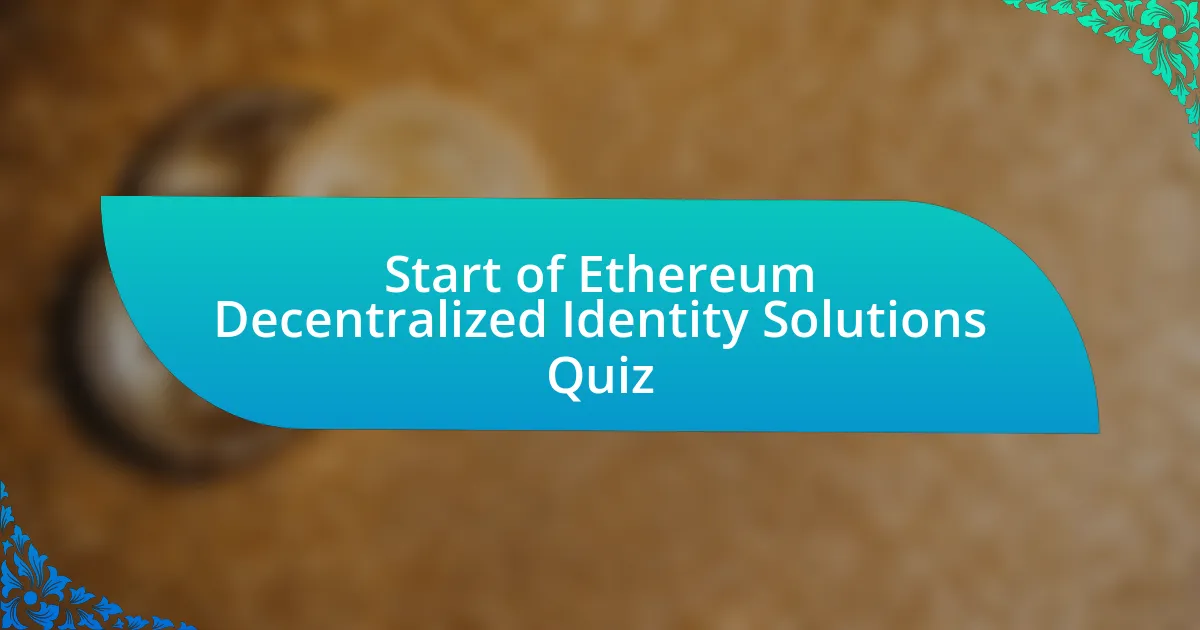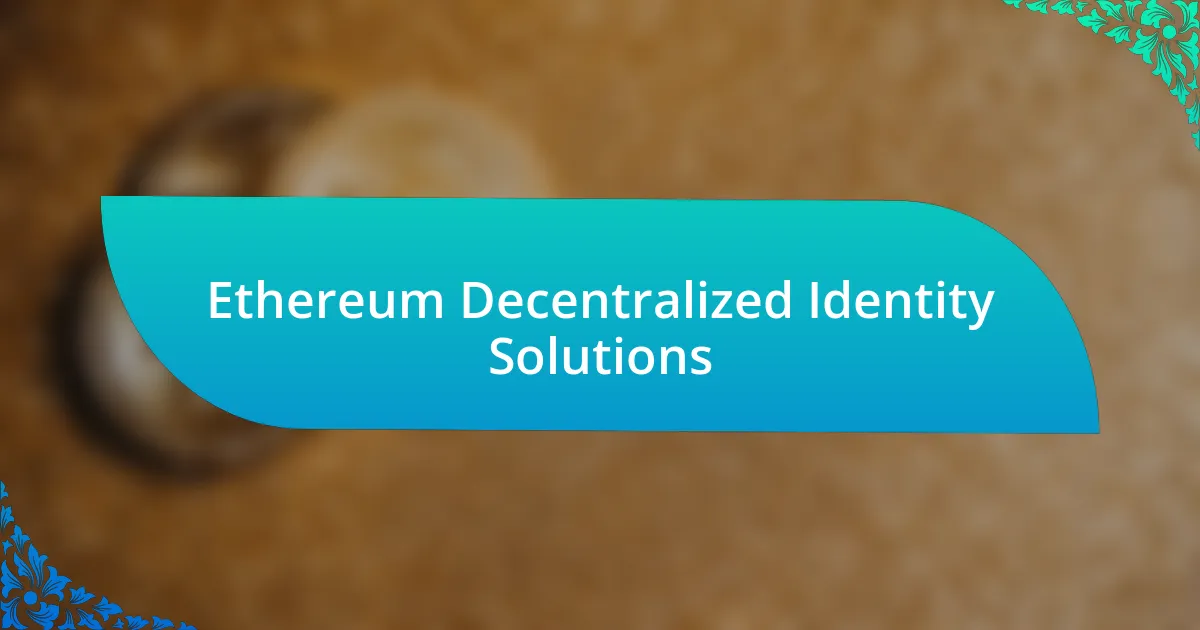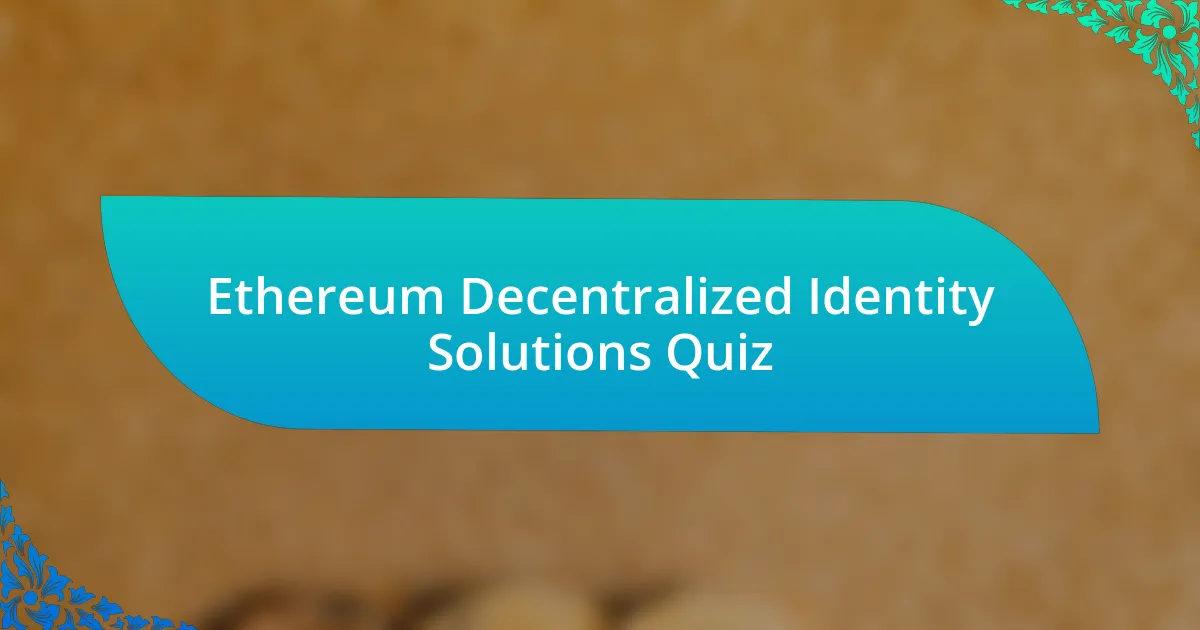
Start of Ethereum Decentralized Identity Solutions Quiz
1. What is decentralized identity?
- Decentralized identity refers to a method of verifying identities using only social media accounts.
- Decentralized identity is a system where all user data is stored in a central database managed by a single authority.
- Decentralized identity is a new approach to digital identity management that leverages blockchain technology to enable individuals to control their identity-related information.
- Decentralized identity is a process where users have no control over their personal information.
2. Who are the original authors of Ethereum?
- Vitalik Buterin and Gavin Wood.
- Satoshi Nakamoto and Hal Finney.
- Charles Hoskinson and Justin Sun.
- Nick Szabo and Gavin Andresen.
3. What is the purpose of decentralized identifiers (DIDs) in Ethereum?
- DIDs are temporary IDs assigned by central authorities.
- DIDs are standard usernames used in social networks.
- DIDs are passwords for blockchain access.
- DIDs are unique identifiers created and controlled by users on the blockchain.
4. How are DIDs secured?
- DIDs are secured through email verification and cloud storage.
- DIDs are secured via social media authentication and public databases.
- DIDs are secured by private key cryptography and stored on immutable ledgers.
- DIDs are secured by password protection and centralized servers.
5. What is the role of verifiable credentials (VCs) in decentralized identity?
- VCs are temporary tokens that users must renew frequently for access to services.
- VCs are usernames created by users for social media platforms to protect their privacy.
- VCs are digital attestations issued by trusted entities that users can present to prove certain aspects of their identity.
- VCs are central databases that store all user identities for verification purposes.
6. Who issues verifiable credentials?
- Random individuals issue verifiable credentials.
- Anonymous users issue verifiable credentials.
- Social media platforms issue verifiable credentials.
- Trusted entities such as governments, educational institutions, or employers issue verifiable credentials.
7. How are verifiable credentials verified?
- Verifiable credentials are verified using cryptographic proofs on the blockchain to ensure their authenticity and legitimacy.
- Verifiable credentials are verified by checking them against a centralized database for accuracy.
- Verifiable credentials are verified through biometric scans and facial recognition technology.
- Verifiable credentials are verified by sending them via email for manual confirmation by a verifier.
8. What is the benefit of using decentralized identity solutions?
- Reduced data accuracy
- Greater server reliance
- Enhanced privacy
- Increased processing speed
9. What is the technical infrastructure of decentralized identity?
- The technical infrastructure includes firewalls, antivirus software, user agreements, and data encryption policies.
- The technical infrastructure includes decentralized identifiers (DIDs), verifiable credentials (VCs), identity wallets, issuers, and verifiers.
- The technical infrastructure consists of centralized databases, user profiles, access logs, and server-side authentication.
- The technical infrastructure involves social media accounts, email verification, password resets, and cloud storage.
10. How do users create DIDs?
- Users create DIDs through phone verification with a service provider.
- Users create DIDs manually by writing them down on paper.
- Users create DIDs using an identity wallet, which records the DID on the blockchain.
- Users create DIDs by sending an email to a central authority.
11. What is the process of managing DIDs and VCs?
- Users only manage DIDs without handling VCs.
- Users store their DIDs and VCs in their identity wallet.
- Users have no control over their identity data.
- Users rely on centralized databases for identity storage.
12. Who manages the data in decentralized identity systems?
- Users
- Data brokers
- Central authorities
- Third-party software
13. What is the role of blockchain in decentralized identity systems?
- Blockchain ensures the security and immutability of DIDs by recording them on a decentralized ledger.
- Blockchain replaces all traditional identity management platforms entirely.
- Blockchain reduces the speed of data processing in identity systems.
- Blockchain eliminates the need for any digital identity verification.
14. How does blockchain technology secure data in decentralized identity systems?
- Blockchain technology secures data using cryptographic algorithms, making unauthorized access or tampering virtually impossible.
- Blockchain technology secures data through regular software updates and firewalls, maintaining system integrity.
- Blockchain technology secures data by centralizing control and monitoring user access closely.
- Blockchain technology secures data by encrypting it with passwords, allowing only approved users access.
15. What is the process of verifying identity in decentralized identity systems?
- Utilizing a centralized database
- Presenting verifiable credentials
- Asking for personal information
- Trusting a single verifier
16. What is an example of a verifiable credential?
- Digital driver`s license
- Social security number
- Passport application
- Birth certificate request
17. How does a user request a verifiable credential?
- A user sends an email to an unverified source asking for a verifiable credential.
- A user asks a random person for a verifiable credential.
- A user requests a verifiable credential from a trusted issuer, such as a government agency or educational institution.
- A user automatically receives a verifiable credential without request.
18. What is the benefit of using decentralized identity in the context of Web3?
- Increased reliance on centralized databases.
- Enhanced user control over digital identities.
- Limited access to personal information.
- Fewer choices for identity management.
19. What are the core principles of decentralized identity?
- The core principles consist of social networking, open access, and transaction fees.
- The core principles are financial transactions, user profiling, and centralized control.
- The core principles include user sovereignty, privacy, and security.
- The core principles involve anonymity, data ownership, and public disclosure.
20. How does decentralized identity shift control from centralized authorities?
- Decentralized identity allows users to control their data directly via blockchain.
- Decentralized identity depends on social media platforms for identity verification.
- Decentralized identity requires a central authority for approvals.
- Decentralized identity shifts control by creating anonymous identities centrally.
21. What is the difference between traditional identity management systems and decentralized identity systems?
- Traditional systems rely on centralized intermediaries, while decentralized systems allow individuals to manage their identity-related information independently.
- Traditional systems provide more security through central control, unlike decentralized systems.
- Decentralized systems involve multiple parties verifying identity instead of users.
- Decentralized systems depend on local databases for user data management.
22. What is the significance of decentralized identifiers (DIDs) in decentralized identity?
- DIDs are identifiers assigned and managed by a central organization for user convenience.
- DIDs are temporary identifiers generated for anonymous online activities, lacking user ownership.
- DIDs are unique identifiers that are created, owned, and controlled by users, independent of any central authority.
- DIDs are only used for tracking user activities on social media platforms.
23. How do identity wallets facilitate the management of DIDs and VCs?
- Identity wallets provide a centralized control to manage DIDs and VCs for users.
- Identity wallets are used solely for sending and receiving cryptocurrency.
- Identity wallets allow users to create, store, and manage their DIDs and VCs, enabling them to decide when and with whom to share their credentials.
- Identity wallets only store personal information, but do not manage their DIDs and VCs.
24. What is the role of verifiers in decentralized identity systems?
- Verifiers store user data on centralized servers for easy access.
- Verifiers issue new decentralized identifiers without user input.
- Verifiers create digital credentials for users based on their data entries.
- Verifiers validate the authenticity of DIDs and VCs using cryptographic proofs on the blockchain.
25. What is an example of a decentralized identity workflow?
- Alice creates a DID, requests a digital driver`s license, and stores it.
- David registers an account using his email address on a forum.
- Carol fills out a paper form to apply for a loan at a bank.
- Bob uses a username and password to log in to a website.
26. How do decentralized identity solutions enhance privacy?
- Decentralized identity solutions enhance privacy by making user data public and accessible to everyone.
- Decentralized identity solutions enhance privacy by requiring users to share all their data with third parties.
- Decentralized identity solutions enhance privacy by allowing users to control their data and decide who has access to personally identifiable information (PII).
- Decentralized identity solutions enhance privacy by storing data in a single centralized location.
27. What is the benefit of using private key infrastructure in decentralized identity?
- Private key infrastructure increases reliance on centralized databases.
- Private key infrastructure eliminates all privacy concerns entirely.
- Private key infrastructure ensures that identity-related information is secure and private.
- Private key infrastructure allows unlimited access to identity data.
28. How do decentralized identity systems reduce dependency on centralized databases?
- Identity information is solely maintained on a user`s local device without any backup systems.
- Decentralized identity systems rely on third-party verification services for managing user data.
- Decentralized identity systems store DIDs and VCs on a blockchain, making them tamper-proof and verifiable.
- Centralized databases collect and manage user data through a single server, risking security.
29. What is the relationship between decentralized identity and Web3 technologies?
- Decentralized identity leverages Web3 technologies to enable individuals to manage their digital identities securely and privately.
- Decentralized identity relies on central authorities to manage user data.
- Decentralized identity is solely focused on social media account management.
- Decentralized identity is an outdated method for managing usernames and passwords.
30. What are the key components of decentralized identity?
- Usernames, passwords, email addresses, social media accounts.
- Central authorities, government IDs, biometric data, profiles.
- Centralized databases, verification processes, user agreements, storage systems.
- Decentralized identifiers (DIDs), verifiable credentials (VCs), identity wallets, issuers, and verifiers.

Congratulations! You’ve Successfully Completed the Quiz
Thank you for taking the time to explore our quiz on Ethereum Decentralized Identity Solutions. We hope you found the questions engaging and informative. This topic is pivotal as it delves into how blockchain technology can transform personal identity management. Understanding these concepts is essential in today’s digital landscape.
Throughout the quiz, you may have gained insights into the mechanisms of decentralized identities. You likely learned about the importance of privacy, security, and user control within Ethereum’s framework. These aspects are crucial for fostering trust in digital interactions. Such knowledge not only enhances your understanding but also prepares you for future discussions on technology and privacy.
If you’re eager to further your knowledge, we invite you to check out the next section on this page. It contains comprehensive information about Ethereum Decentralized Identity Solutions. Expanding your understanding of this topic will empower you to navigate the evolving digital world with confidence. Dive in and discover more!

Ethereum Decentralized Identity Solutions
Understanding Ethereum Decentralized Identity Solutions
Ethereum decentralized identity solutions integrate blockchain technology to offer self-sovereign identity management. These solutions empower users to control their own identities without relying on centralized authorities. The use of smart contracts facilitates secure and verifiable identity transactions on the Ethereum blockchain. This approach enhances privacy and reduces the risks associated with identity theft and unauthorized data access.
The Role of Smart Contracts in Decentralized Identities
Smart contracts automate the management of decentralized identities. They define the rules and conditions under which identity attributes can be shared or verified. These programmable agreements operate autonomously on the Ethereum blockchain, ensuring transparency and trust. By eliminating intermediaries, users have greater control over their data and the ability to grant permissions selectively.
Benefits of Using Ethereum for Identity Solutions
Using Ethereum for identity solutions offers several key benefits. First, it ensures high levels of security through cryptographic techniques. Second, it fosters interoperability among different services and platforms. Third, users can maintain privacy while still proving their identities as needed. The decentralized model significantly reduces the risk of single points of failure inherent in traditional identity systems.
Protocols and Standards in Ethereum Identity Solutions
Protocols like ERC-725 and ERC-735 define the standards for decentralized identities on Ethereum. These standards facilitate the creation and management of self-sovereign identities. They enable users to issue, manage, and verify identity claims without third-party involvement. By adhering to these protocols, developers can ensure compatibility and encourage wider adoption across the ecosystem.
Real-World Applications of Ethereum Decentralized Identity Solutions
Real-world applications of Ethereum decentralized identity solutions span various industries. In finance, they support Know Your Customer (KYC) processes, streamlining customer verification. In healthcare, they secure patient data while allowing easy access to authorized personnel. Additionally, in education, they verify academic credentials directly on the blockchain, enhancing authenticity and reducing fraud.
What are Ethereum Decentralized Identity Solutions?
Ethereum Decentralized Identity Solutions are frameworks that leverage blockchain technology to create secure, self-sovereign identities. These solutions allow individuals to control their personal data without relying on centralized authorities. For instance, many projects utilize Ethereum’s smart contracts to manage identity verification processes, ensuring privacy and security.
How do Ethereum Decentralized Identity Solutions work?
Ethereum Decentralized Identity Solutions work by using blockchain to store identity data in a secure manner. Users create a digital identity that resides on the Ethereum blockchain, typically represented as a cryptographic key pair. Transactions related to this identity are signed and verified on the blockchain, which enhances security. For example, the Self-Sovereign Identity (SSI) model allows users to manage their credentials and selectively share them with others while maintaining control.
Where are Ethereum Decentralized Identity Solutions being applied?
Ethereum Decentralized Identity Solutions are being applied across various sectors such as finance, healthcare, and education. In finance, they help verify customer identities for compliance with regulations. In healthcare, they enable patients to control access to their health records securely. Projects like uPort and ConsenSys’ Myco are examples showcasing applications in these areas.
When did Ethereum Decentralized Identity Solutions emerge?
Ethereum Decentralized Identity Solutions began to emerge around 2017, coinciding with the rise of blockchain technology and decentralized applications. The concept gained traction as developers recognized the potential of using Ethereum’s smart contracts to build secure identity systems. The Decentralized Identity Foundation was also established in 2018, further advocating for these innovations.
Who is involved in the development of Ethereum Decentralized Identity Solutions?
Various stakeholders are involved in the development of Ethereum Decentralized Identity Solutions, including blockchain developers, startups, and consortiums like the Decentralized Identity Foundation. Notable projects include ConsenSys and the Ethereum Foundation, which support initiatives for decentralized identity technologies. Additionally, companies such as Microsoft are also exploring decentralized identity frameworks on the Ethereum network.

